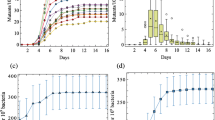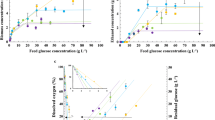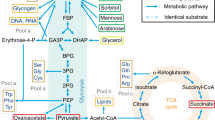Abstract
A tyrosine-requiring strain of Escherichia coli was grown in tyrosine-limited chemostats at a range of dilution rates between 0.08 h-1 and 0.42 h-1, conditions which always resulted in the selection of a prototrophic revertant population able to synthesise tyrosine. Analysis of the two-membered mixed cultures which arose showed that the prototrophic population outgrew the auxotroph since its growth rate was not restricted by the growth-limiting concentrations of exogenous tyrosine. During the take-over of the culture, the prototroph population grew exponentially but the specific growth rate increased with decreasing dilution rate of the competition experiments. In glucose-limited chemostats (in the presence of non-growth-limiting concentrations of tyrosine) of the tyrosine-requiring strain, prototrophs were never detected. Constructed two-membered mixed cultures with both populations competing for limiting amounts of glucose, showed that the prototroph was less competitive than the auxotroph.
Similar content being viewed by others
References
Cox, E. C. and Gibson, T. C. 1974. Selection for high mutation rates in chemostats. — Genetics 77: 169–184.
Gibson, T. C. Scheppe, M. L. and Cox, E. C. 1970. Fitness of an Escherichia coli mutator gene. —Science 169: 686–688.
Godwin, D. and Slater, J. H. 1979. The influence of the growth environment on the stability of a drug resistant plasmid in Escherichia coli K12. — J. Gen. Microbiol. 111: 201–210.
Harder, W. and Veldkamp, H. 1971. Competition of marine psychrophilic bacteria at low temperature. — Antonie van Leeuwenhoek 37: 57–63.
Hartley, B. S., Burleigh, B. D., Midwinter, G. C., Moore, C. H., Morris, H. R., Rigby, P. W. J., Smith, M. J. and Taylor, S. S. 1972. p. 151–176. In J. Drenta, R. A. Oosterbaan and C. Velgar (eds), Enzymes: Structure and function. — North-Holland Publ. Co., Amsterdam.
Jannasch, H. W.. 1967. Enrichment of aquatic bacteria in continuous culture. — Arch. Mikrobiol. 59: 165–173.
Jannasch, H. W.. 1968. Competitive elimination of Enterobacteriaceae from sea water. — Appl. Microbiol. 16: 1616–1618.
Jannasch, H. W. 1969. Estimation of bacterial growth rates in natural waters. — J. Bacteriol. 99: 156–160.
Keilin, D. and Hartree, E. F. 1948. The properties of glucose oxidase. — Biochem. J. 42: 221–229.
Kuenen, J. G., Boonstra, J., Schroder, H. G. J. and Veldkamp, H. 1977. Competition for inorganic substrates among chemoorganotrophic and chemolithotrophic bacteria. — Microb. Ecol. 3: 187–197.
Matin, A. and Veldkamp, H. 1978. Physiological basis of the selective advantage of a Spirillum sp. in a carbon-limited environment. — J. Gen. Microbiol. 105: 187–197.
Moser, H. 1958. The dynamics of bacterial populations maintained in a chemostat. — Publication 614 Carnegie Institute Washington, Washington DC.
Powell, E. O. 1958. Criteria for the growth of contaminants and mutants in continuous culture. — J. Gen. Microbiol. 18: 259–268.
Udenfriend, S. and Cooper, J. R. 1952. The chemical estimation of tyrosine and tyramine. — J. Biol. Chem. 22: 104–123.
Zamenhoff, S. and Eichhorn, H. H. 1967. Study of microbial evolution through loss of biosynthetic functions: establishment of defective mutants. — Nature, London 216: 456–458.
Author information
Authors and Affiliations
Additional information
This work was supported by a grant from the Science Research Council.
Rights and permissions
About this article
Cite this article
Mason, T.G., Slater, J.H. Competition between an Escherichia coli tyrosine auxotroph and a prototrophic revertant in glucose- and tyrosine-limited chemostats. Antonie van Leeuwenhoek 45, 253–263 (1979). https://doi.org/10.1007/BF00418588
Received:
Issue Date:
DOI: https://doi.org/10.1007/BF00418588




